In these times of increased automation for Google advertising, is there any role left for human creativity? The answer is, absolutely because creativity and human intelligence is still very much required when it comes to creating ad copy.
Automation has, to a degree, broken into the copywriting scene for Google advertising but creativity remains a vital asset if you want highly converting ad copy.
What makes ad copy convert? It is a question every PPC advertiser wants to know and something many experts think they have discovered. However, the reality is that there is not one answer to the question but many. Even the best copywriter can create ads that don’t convert. The problem is that, with Google advertising becoming increasingly competitive, your ad copy can’t just be good, it has to be great.
All your fabulous landing page structure, forms and product images cannot do their job to convert a user if you don’t acquire that essential click. Ad copy, therefore, is all about a combination of enhancing CTR but also having the promises of your copy delivered on your landing page.
With up to seven other ads to compete with and 10 organic listings on page one of search, how can you ensure your copy is the one that is most compelling?
There are a number of essential tactics and techniques which can help a creative copywriter transform their ad copy from pretty good to highly converting. By following these guidelines and pushing your creativity to the max you should be able to vastly improve your ads and increase conversion rates.

1) High search relevancy
Ensuring your ad is relevant to users is the foundation of great ad copy. In fact, relevancy is probably the most important element when considering every feature of PPC advertising. It is the centrepiece of good marketing and the more relevant your ad is to a user, the more likely they will be to convert.Relevancy can be understood in many ways, when it comes to crafting good copy, but it is important to start with search relevancy.
Ensuring your text ad copy is as relevant to the user’s search query as possible is crucial in grabbing attention, helping to fulfil their intent and eventually converting them.
To achieve this, you should always try to include your target keywords in the ad copy and preferably in the headline. The importance of including keywords in the ad copy cannot be stressed enough. Not only does this tactic improve quality score and help you show for the right terms, it also helps the users. If they are looking for something quickly they are likely to skim read the search results.
When users skim read, they are not absorbing the language of your ad copy in full. You need to make their search term jump out at them in your ad. That is all their brain is looking for when researching services and products quickly. Including target keywords in ad copy is the foremost way to ensure ad relevancy both to the user, the keyword group and the campaign goal.
Your ad can be as clever, as eloquent and call to action driven as you like but if a user is skim reading, they won’t absorb that message, so never neglect keywords in ad copy.
Below is an example of a perfectly good ad, yet the copy does not include all the keywords of the search query:
 The user could surmise that the clinic does not offer the therapy they desire and click on an organic result or another ad instead.
The user could surmise that the clinic does not offer the therapy they desire and click on an organic result or another ad instead.
Don’t forget that the headline and description line are not the only copy your user sees. Your display URL can also play a pivotal role. Most people, who have never used AdWords themselves, will not realise advertisers can tweak their display URL in ads. They will believe this is your genuine URL but know that you can make any ad copy for the headline and description you like. This means that they will trust the display URL more, as a sign of true relevancy to their search. Hence, if your display URL contains their search query they could determine your site will be right for their needs.
Since users can express themselves in a variety of ways it can be difficult to make sure you have included every possible variation of your target terms and build out ads for each variety.
One solution to this problem is DKI or dynamic keyword insertion. By inserting a very simple formula into your ad copy, you can enable any user search term to be included in the headline. The example below from Wordstream demonstrates how this works in practice:
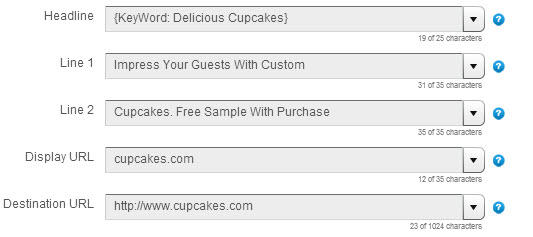

However, if you are looking for great, highly converting ad copy, rather than just good ad copy, then you need to be wary of DKI. You should already be able to guess from the example above how it can go wrong. In this instance, the advertiser might specialise in baked goods and this is their AdGroup targeting cupcakes, however the user is clearly specifying that they are probably only interested in German chocolate cupcakes. If they click the ad and find that the advertiser does not sell these, they may settle for something else but with so much choice these days they are far more likely to be irritated, feel manipulated and abandon your website never to return.
DKI can be manipulative and not deliver on the promises of the ad copy. To create converting ad copy you will be much better off manually researching your keywords and painstakingly building out AdGroups and highly relevant copy to each term. DKIs are also especially notorious for not working well with long-tail keywords.
Building manual ad copy for each search term is time consuming but if you have the time and a small to medium sized stock, it is well worth doing for the sake of better ad copy. This way you can work hard to make sure ad copy is not only relevant but true to your offering.
This is a prime example of how automation is working its way into ad copy creation but not always living up to the creative power of people. Human intelligence can better understand the nuance of facts and human language than automated programs.
Industry experts Wordstream also agree with this approach and believe that, while DKI can be a time saver and sometimes increase relevancy, the very best campaigns with high conversions always go for manual building out. The following graph shows how manual ad copy continues to slightly outperform DKIs:
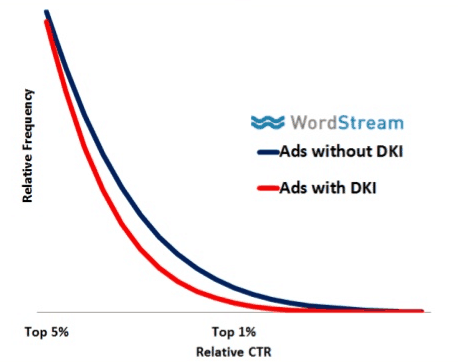
Of course, for companies with very large stock, manual build out of ads, which are highly relevant to user queries, is not feasible. In these cases, you could always run complimentary dynamic search campaigns. These campaigns will at least match search terms to your own landing pages for a more reliable match. It is still preferable to use these alongside manual campaigns as an aid for discovering new relevant keywords, rather than instead of manual campaigns, if your stock size allows for eventual full manual build out.
If you run local services, including location keywords in your ad copy is also highly valuable. It will aid search relevancy by telling local users how easily they can access your services.
It isn’t just local businesses who will benefit. Customers often prefer local services even if a national company could have also adequately delivered on their promise. Being local means users feel they can more easily address concerns and feel heard by brands, so never underestimate the power of local relevancy. Even for big e-commerce sites, users may prefer a more local branch in case they wish to try on a fashion item, having researched online rather than buying online.
Local keyword copy plus correct geotargeting is a good starter recipe for success for local services.
2) High audience relevancy
Including keywords in your copy is not the only way to improve the relevancy of your ad to your users. As you gather data from your campaign you can begin refining it and making it more relevant to different audience types.You may already have a good idea of the persona of your target audience e.g. young professional men age 25- 40. Yet, most products and services will be applicable to a range of audiences and these different demographics may respond to copy differently. Words and USPs that resonate with one group may not work as well for another.
In our recent blog on 6 PPC campaign hacks to improve conversions rates we discussed the value in creating different landing pages for different target audiences. As you gather data you can segment your campaigns not only by device or funnel level or long-tail vs short-tail, you can also segment it by audience types. This allows you to test which landing page content, visuals and calls to action work best for each target demographic. Professional women in their 30s, retired men and many other groups may need legal help with their wills but may not respond equally to the same language or visuals or even the same motivations.
To ensure that you correctly target these various groups, you must also alter the copy of the ads themselves and make sure it is compatible with your landing page. In order to attract the right audience, you could even mention who the ad is intended for in the copy. This helps users connect with your ad and know it is relevant to their life situation. Once you start to get an idea of which ads are working, you can then build out separate campaigns, AdGroups and ads for these different audience personas.
An example could be experimenting with more formal or casual language or focusing on different features of your product depending on the envisioned users, e.g. the price for certain income groups or the colour and style range, the flexibility, productivity, time saving, luxury aspects etc. By envisioning what matters most to each demographic you can better tailor ad copy to their psychology.
Tailoring your ad copy to different demographics and personalities is not the only way to increase relevancy with your audience. Another effective way is by crafting ads to match each stage of the conversion funnel.
Campaign objectives should lead all optimisation. That means you should consider what the campaign is trying to achieve. Is it brand awareness, increased traffic numbers, more subscribers to your newsletter, more leads or more conversions?
These objectives need to be reflected by an understanding for and appreciation of the customer journey. By trying to sell to customers who are not ready, your ads will have a lower conversion rate. The other end of the spectrum is trying to offer whitepapers and awareness content to users who are ready to buy. This is a distraction and counter intuitive.
Just as you would segregate campaigns by demographic and tweak copy accordingly, so too should you segregate by where the customer is in their journey. This is why it is valuable to separate research and educational awareness keywords from campaigns with high intent keywords. The ad copy for these campaigns needs to be different. Awareness campaigns should not be filled with ‘buy now’ rhetoric they need to educate. Mid-level campaigns need to offer evidence and solutions to problems, to help convince users further down the funnel. Finally, the high intent keyword campaigns need heavily action driven copy.
Here is a good example of the kind of offering to include in ad copy for the different buyer level campaigns:

Klientboost offers an elegant example to explain the problem of not aligning your ad copy with the customer journey. Consider the situation of a car problem. When your transmission fails you are not in the mind frame to sell your car straight away, even though this might be the best thing to do. Targeting ads with copy about selling your car towards keywords about fixing a transmission can be too forward for the user. It is best to offer educational information on how to fix a transmission or repair services, where you can then show the user that selling their car is a better course of action. They will then make higher intent searches and hopefully convert. The following example of ad copy strikes an excellent balance to convince users to consider selling their car in the event of a broken transmission:

3) High landing page relevancy
Technically the best ad copy alone will not increase your conversion rates. It can only increase your CTR. For you to actually create high converting ad copy in your Google advertising it must deliver on a promise.To do this, ad copy must be informative above all else and must work together with your landing page and the services itself to deliver on this promise.
Informative copy must not be mistaken for boosting your own ego by bragging about USPs. USPs are important but what you consider the best features of your service or product may not be what the user cares about.

Including price, details on your range, any benefits or how your product solves a common problem are good starting points for the copy. To really know which USPs or features your users care about, you should analyse comments and reviews made by previous customers and even ask them in your email marketing with surveys. While you may think you competitive price is the biggest selling point, for users it could be that the product is easy to transport.
This technique can improve your ad copy and help you make improvements in your service or product. Remember the best way to drive conversions is to have a good product.
Most importantly your ad copy must be reflected on the landing page and be true for it to create conversions.
4) Keep ads up to date with world relevancy
Relevance has remained a major theme in our advice on highly converting ad copy. There is good reason for this. Despite all other excellent techniques, without focusing on all aspects of relevancy to the audience: their personality, their journey, their search terms, you will not create great ads.While not as vital as other forms of ad relevancy, there is one more which can add a little boost to your ads: real world relevancy.
Ads can very quickly stagnate and keeping them up to date is useful. By adding references to relevant real-world events, your ad copy appears current and on the ball.
If you run a sporting goods business, ads making reference to the Olympics or World Cup can make them more relevant to what is taking place in the world of your audience, these ads also appear more current.
5) Use expanded text ads to their full potential
Now that you have the most essential tactics of ad copy relevancy understood, you are well on your way to high converting ad copy. Advertisers can then turn their attention to the little tweaks and corrections that give ad copy even greater lift.The rollout of expanded texts ads is a huge benefit to advertisers. One of the greatest struggles in writing ad copy for AdWords has been the narrow character limits. This made it difficult to include keywords, USPs and calls to action, while being eloquent, grammatically correct and relevant. It gave little room for finesse and led to generic ads.
Fortunately, expanded text ads give your copywriters and PPC marketers a little more wiggle room. The headline has increased from 25 characters to 30 characters and the description line has increased from 35 to 80 characters. This may not seem like a great deal but it gives far more room for correct punctuation and to make your ad copy more unique. Take a look at the big difference between the following standard text ad and expanded ad:
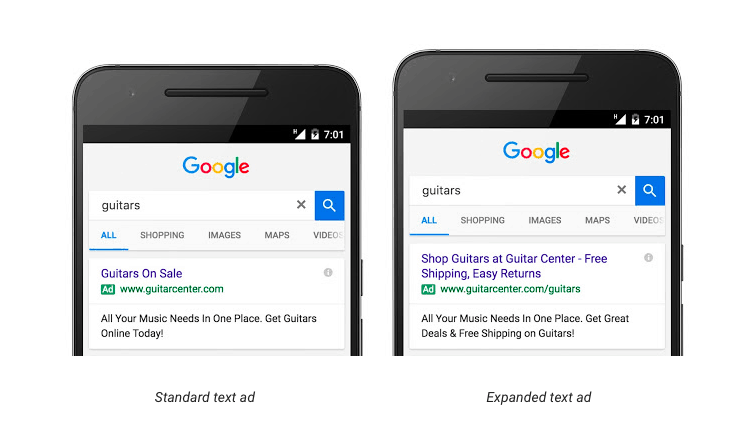
6) Avoid spammy sounding ads
This may seem like obvious advice but articulation and punctuation often fall by the wayside when advertisers need to squeeze messages into a tight space. You should never forego punctuation or start using text speak in an effort to include the desired message. Nothing looks worse than poor spelling and grammar in an ad. The expanded text ads should enable you to achieve this advice more easily.7) Use different copy for different devices
In addition to having high quality, relevant ad copy, your language and messages need to suit their medium.Many PPC experts advise splitting campaigns by device types and this is not just beneficial for putting money behind the best converting device, it also helps you tailor your ad copy appropriately.

What converts on one device won’t necessarily do the same for another. This is because peoples’ mind set can be different on each device. Well over 50% of all searches are now performed on mobile but consumers still use the devices differently.
Mobiles are easy to transport, you can make calls from them and we can search on the go. They also have a much smaller screen and these factors lend themselves to different ad copy styles.
While expanded text ads are advantageous across all devices it is best to keep language focused on efficiency in mobile ads. Shorter, faster, informative and immediate satisfaction driven ad copy is the goal.
Advertisers should also remember to drive calls and reassure customers that purchase online will not be a hassle. If they feel it will be fast to buy on a mobile, they could convert then and there, rather than just researching with the view to returning on desktop later. In this time, they could forget your business. Focus on language like ‘tap to ring’, ‘quick and easy online ordering’ or ‘tap to buy now’. This shows you know the user is on a mobile or tablet, whereas if you had said ‘click to buy online’ it is obvious that the user is on a desktop computer.
8) Include numbers
USPs are good but numbers are better. Statistics and numbers feel more factual and can be more informative.Including prices is one of the best ways to be upfront and honest with customers and if your rates are genuinely competitive it will increase your conversion rates. If you are not so competitive in your prices, at least the traffic that does come through will be qualified and likely to convert because you were informative and honest.
A great way to include numbers, boast about a USP and stay up to date, is to include stats on how much money you saved customers in the last month, this also helps keep the ad current.
Another clever way to use numbers is to give exact figures rather than rounded numbers, for example when explaining the purity rate of a product or your success rate. Exact figures seem more real to customers than saying 100% success rate, as they are smart enough to know that no business is perfect. Exact figures instil trust.
9) Use emotion but don’t overuse urgency
Veteran copywriters know that emotive text is a key component in pushing conversions. Fear is one of the most commonly used emotions, as it is one of the most primal. People hate missing out and so creating a feeling of urgency or danger can be compelling.However, it is important not to overuse fear. Every single tactic used to elicit consumer emotions, no matter how effective, eventually weakens. The more advertisers who create effective urgency in their ads, the more people will become immune. Remember Google ads are not life or death matters for your audience, so they can easily reject you if you overuse an emotive tactic.
Focusing on positive emotions and more subtle emotions can be a great workaround for your Google advertising. Limited time offers, if expressed correctly, can feel positive and create urgency e.g. ‘free shipping ending soon’.

Other emotions to weave into ad copy can be excitement or even guilt as shown by these examples:

Another tactic for inciting urgency without over using fear are countdown timers. Without attempting to manipulate with language, countdown timers in ad copy very clearly state when an offer is ending or registration for an event is closing. This can be both informative and emotive, yet subtle.
Countdown timers have a good track record of driving conversions too. The Clarks America company saw a 32% increase in CTR and a 3% increase on conversion rates from using the countdown timers.
Take a look at the excellent example below to help get you started on crafting different ad copy for various emotional responses:
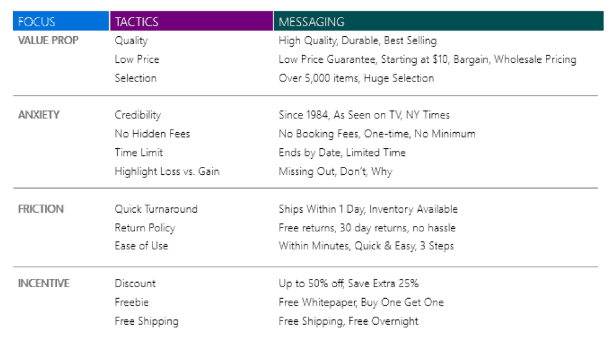
10) Don’t forget extensions
Your headline, description text and display URL are not the limits of your ad copy. Extensions, such as sitelinks, review extensions and callouts can add additional copy to your ads.All of these contribute to the message of the ad copy and it is important to give just as much consideration to the message they send.
It is best to add extensions at the AdGroup level to ensure maximum relevancy to your keywords. All ad copy should support the message and objective you are trying to achieve.
The additional copy from extensions also helps your ad take up more space. In the three examples below the first ad uses sitelinks, location extensions and call extensions and is more prominent that the two latter ads.

However, instead of inserting every extension possible into every campaign, you should tailor your chosen extensions to your campaign objective, your audience and your target keywords, just as you would with the rest of the ad copy.
11) Write compelling calls to action
Calls to action are essential parts of your ad copy because they let the user know how they can fulfil their desires via your business.Whether you urge them to call, click, buy or fill out a form to achieve their goals, you are succeeding in delivering motivation and direction.
To write highly converting ad copy, your calls to action should inform but be non-pressurising. Again, this relates to choosing the right copy for the customer journey because a bossy call to action can be a repellent to an unsure user.
Adding incentive based calls to action is an ideal way to convince your audience. Instead of phrases like ‘buy now’ try ‘order today for fast delivery’ or ‘free delivery for all orders before 24th July’. These calls to action direct users to a benefit.
Naturally, different language for your calls to action work better for different goals. For higher priced products or service based industries ‘learn more’ or ‘discover more’ is far more effective than ‘order now’ because it appreciates the big decision the user must make.
Here are some key examples of this phenomenon shared by Clicteq and originally created by PPC Hero. They show which CTAs prove most successful for e-commerce and service based industries:
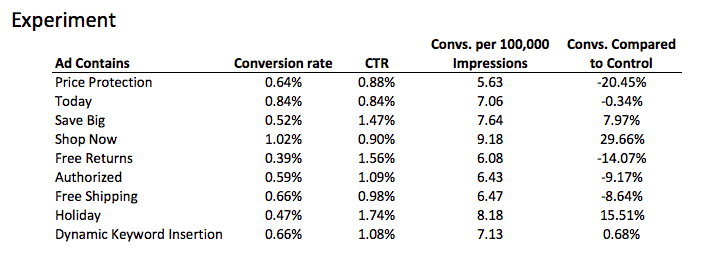

12) Pre-qualify leads
One of the most important ways to ensure a good conversion rate from your ad copy is to pre-qualify your leads. There are many cases where the product is great, the landing page is excellent and the ad copy works well but high conversions are not achieved. Good ad copy can drive a high CTR but if it fails to qualify those leads, they are less likely to produce good conversions.Even when the promise of the ad copy is delivered by the landing page, some products or services may not be suitable for everyone, for example if a product is not good for sensitive skin or a service is not suitable to small businesses. In these cases, the ad copy may seem relevant to the user but when they investigate further or enquire, they are not the prospect you had in mind.
By clearly stating prices and the intended audience for your service e.g. businesses with over 50 employees, you can qualify leads before they get to your site and thereby ensure more relevant leads. This is especially pertinent for lead generation and B2B businesses.
13) Don’t neglect the traditional search network for your e-commerce store
More and more e-commerce stores are using Google Shopping as opposed to text ads in the traditional search network. This is in part thanks to those business recognising the value of Google Shopping for their industry and also in part thanks to Google pushing this service.Google Shopping delivers a great user experience for e-commerce stores because consumers can easily compare products before heading over to your landing page.
The result is a slight reduction in competition on the search network for e-commerce stores, which is a big opportunity. For many product searches Google immediately pushes shopping at the top of search results instead of ads.

The problem is that the shopping network leaves it up to Google to decide which searches are relevant to your product data sheet. This takes a lot of targeting control away from your Google advertising.
Text ads on the search network may be less visual but they allow far more precision in tailoring copy to keywords. Bearing this is mind, e-commerce stores should remember not to abandon the search network in favour of Google Shopping. Instead they should use them as complementary tools to achieve their goals.
The lack of precision in targeting on Google Shopping can also lead to dissatisfactory results. Take a look at this search for white leather knee high boots, which produces three results that are not even white boots:

It is possible the company also provides a white version but on Google Shopping consumers are judging you by the image first and foremost and this could lose you a sale. Ad copy on the search network allows the opportunity to explain your product range.
14) Use familiarity in copy for RLSA ads
Most advertisers are aware that remarketing produces greater conversion rates because the user has already shown an interest in your website. You can enhance this in your Google advertising for even more conversions by using familiarity in your RLSA ad copy.If you created segmented remarketing lists for each of your products, services or product categories, then you can confidently craft more specific ad copy to users.
You can elicit familiarity by referring to the fact that visitors have been on the site before and/or that there is an offer on the product they looked at, e.g. ‘Don’t forget those red patent shoes you loved. They are now only $75.’
15) Use multi-variant testing
Naturally, the best way to write truly converting ad copy is to follow all our tips and then employ multi variant testing. You will only know what really works for your business if you experiment, test and follow the data to discover which audiences respond best to which copy. Apply our theories but create several versions of each ad and test them to discover which selection of copy works best to drive those conversions: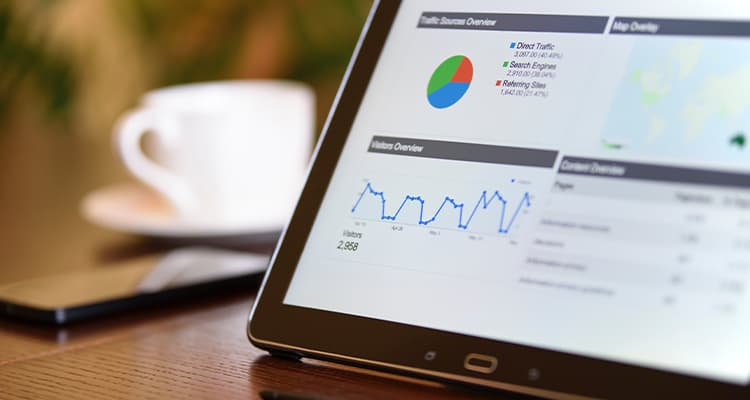
16) Be unique
In the competitive world of Google advertising the best thing you can do is stand out. With so many advertisers using best practice and creative techniques to gain conversions, it makes it harder to defeat competitors.That is why it is best to put your creativity and copywriting skills to the test and be brave enough to try something new. Try being adventurous, funny or even a little odd with your ads and see if it grabs attention. Test these techniques against more controlled ad copy to see if uniqueness is the key to your success.
While being unique or just plain strange with your ad copy can grab attention, the best convertors balance originality with humour and relevancy. One of our favourite examples is the copy in this display ad shared by Acquisio:
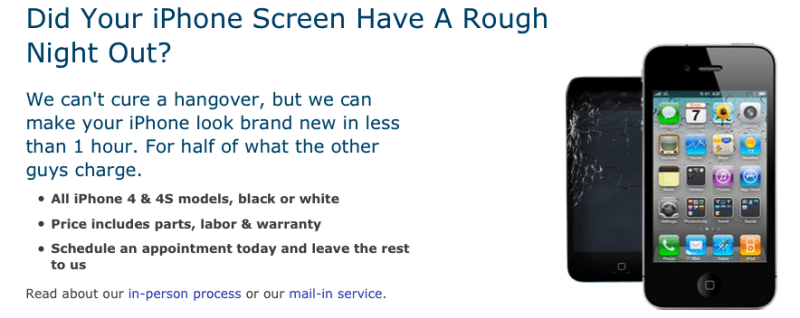
The slightly anthropomorphised phone is used as a humorous observation on the realities of modern life and it works wonders.
If you are a creative writer and can follow these 16 guidelines, you will soon be developing high quality and high converting ad copy for your Google advertising.


